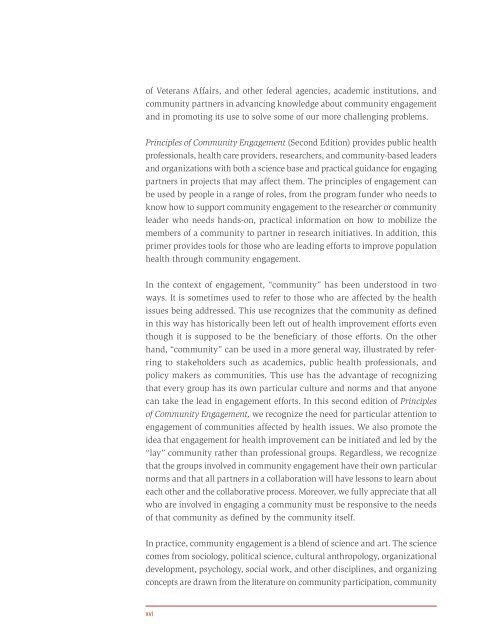Principles of Community Engagement (Second Edition)
Principles of Community Engagement (Second Edition)
Principles of Community Engagement (Second Edition)
You also want an ePaper? Increase the reach of your titles
YUMPU automatically turns print PDFs into web optimized ePapers that Google loves.
<strong>of</strong> Veterans Affairs, and other federal agencies, academic institutions, and<br />
community partners in advancing knowledge about community engagement<br />
and in promoting its use to solve some <strong>of</strong> our more challenging problems<br />
<strong>Principles</strong> <strong>of</strong> <strong>Community</strong> <strong>Engagement</strong> (<strong>Second</strong> <strong>Edition</strong>) provides public health<br />
pr<strong>of</strong>essionals, health care providers, researchers, and community-based leaders<br />
and organizations with both a science base and practical guidance for engaging<br />
partners in projects that may affect them The principles <strong>of</strong> engagement can<br />
be used by people in a range <strong>of</strong> roles, from the program funder who needs to<br />
know how to support community engagement to the researcher or community<br />
leader who needs hands-on, practical information on how to mobilize the<br />
members <strong>of</strong> a community to partner in research initiatives In addition, this<br />
primer provides tools for those who are leading efforts to improve population<br />
health through community engagement<br />
In the context <strong>of</strong> engagement, “community” has been understood in two<br />
ways It is sometimes used to refer to those who are affected by the health<br />
issues being addressed This use recognizes that the community as defined<br />
in this way has historically been left out <strong>of</strong> health improvement efforts even<br />
though it is supposed to be the beneficiary <strong>of</strong> those efforts On the other<br />
hand, “community” can be used in a more general way, illustrated by referring<br />
to stakeholders such as academics, public health pr<strong>of</strong>essionals, and<br />
policy makers as communities This use has the advantage <strong>of</strong> recognizing<br />
that every group has its own particular culture and norms and that anyone<br />
can take the lead in engagement efforts In this second edition <strong>of</strong> <strong>Principles</strong><br />
<strong>of</strong> <strong>Community</strong> <strong>Engagement</strong>, we recognize the need for particular attention to<br />
engagement <strong>of</strong> communities affected by health issues We also promote the<br />
idea that engagement for health improvement can be initiated and led by the<br />
“lay” community rather than pr<strong>of</strong>essional groups Regardless, we recognize<br />
that the groups involved in community engagement have their own particular<br />
norms and that all partners in a collaboration will have lessons to learn about<br />
each other and the collaborative process Moreover, we fully appreciate that all<br />
who are involved in engaging a community must be responsive to the needs<br />
<strong>of</strong> that community as defined by the community itself<br />
In practice, community engagement is a blend <strong>of</strong> science and art The science<br />
comes from sociology, political science, cultural anthropology, organizational<br />
development, psychology, social work, and other disciplines, and organizing<br />
concepts are drawn from the literature on community participation, community<br />
xvi

















